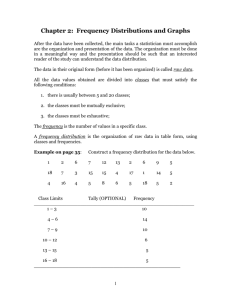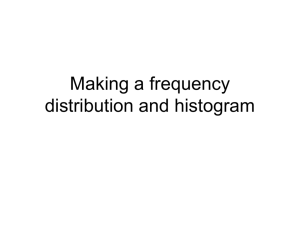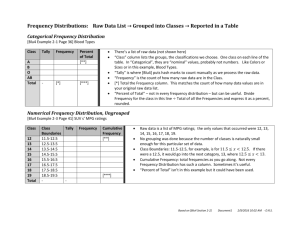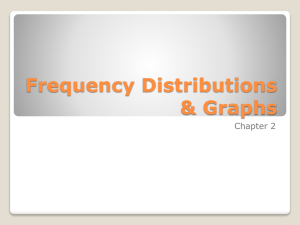Grouped Frequency Distribution - Greer Middle College || Building
advertisement
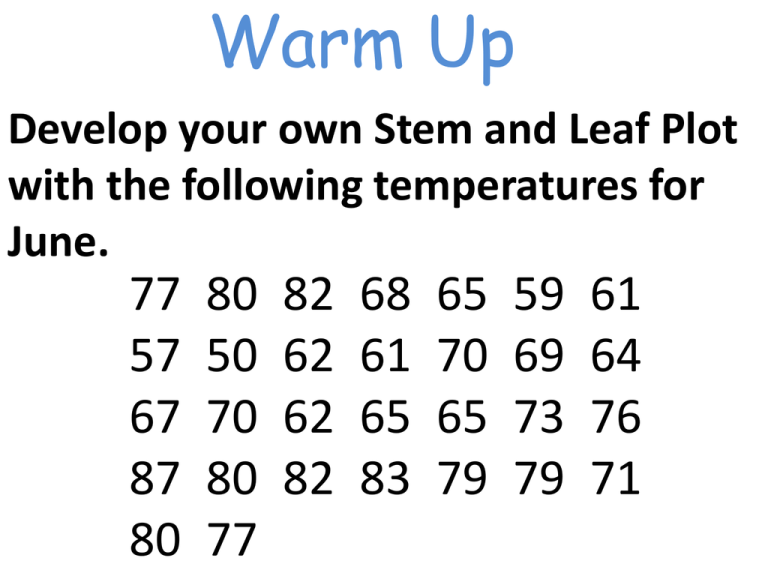
Warm Up Develop your own Stem and Leaf Plot with the following temperatures for June. 77 57 67 87 80 80 50 70 80 77 82 62 62 82 68 61 65 83 65 70 65 79 59 69 73 79 61 64 76 71 Warm Up Answer: 5 6 7 8 079 11224555789 001367799 0002237 Lesson 5: Frequency Frequency is how often something occurs. Example: Sam played football on… • Saturday morning • Saturday afternoon • Sunday afternoon The frequency is: http://www.mathsisfun.com/data/frequency-distribution-grouped.html Categorical Frequency Distribution By counting frequencies we can make a frequency distribution table A categorical frequency distribution is used for data that can be placed into specific categories. Creating a Categorical Frequency Distribution Step 1: Make a table with the following columns in order: class, tally, and frequency Creating a Categorical Frequency Distribution Step 2: Tally the data and place the results in the tally column. Creating a Categorical Frequency Distribution Step 3: Count the tallies and place the results in the frequency column. Example Categorical Frequency Distribution These are the favorite colors of fifteen 2nd graders. Red Yellow Green Red Blue Class Blue Red Red Green Red Tally Green Yellow Red Blue Green Frequency Total= What about if the categories of data are numbers? Grouped Frequency Distribution A frequency distribution with classes that are more than one unit in width When the range of the data is large, the data must be grouped into classes 41 105 109 104 57 99 112 107 105 118 67 99 87 78 101 95 125 92 Key Concept Class Width The class width is the range of the class. Can be found by subtracting the lower class limit of one class from the lower class limit of the next class Rules For Grouped Data Rule #1: Choose the classes You will normally be told how many classes you need Rule #2: Choose Class Width ALWAYS round up to the next whole number Rule #3: Mutually Exclusive This means the class limits cannot overlap or be contained in more than one class. Rules For Grouped Data Rule #4: Continuous Even if there are no values in a class the class must be included in the frequency distribution. There should be no gaps in a frequency distribution. (with the exception of a class with zero frequency) Rule #5: Exhaustive There should be enough classes to accommodate all of the data Rule #6: Equal Width This avoids a distorted view of the data. Creating a Frequency Distribution Step 1: Determine the minimum and maximum values, and how many classes you need Creating a Frequency Distribution Step 2: Find the class width Class Width = __Range__ # of classes *ALWAYS round up to the next whole number Creating a Frequency Distribution Step 3: Write your minimum value as your lowest lower limit Minimum value Class Limits 2 Creating a Frequency Distribution Step 4: Add the class width to your lower limit to find the next lower limit; WRITE BELOW NOT BESIDE! (do all lower limits first) Class Limits Ex: Class width = 9 2 11 20 29 Go until you have the amount of classes needed (in this case 4) Creating a Frequency Distribution Step 5: To find each upper limit, subtract one from the next lower limit Class Limits 2 - 10 11 - 19 20 - 28 29 Creating a Frequency Distribution Step 6: To find last upper limit, add class width to the 2nd to last upper limit Class Limits 2 - 10 11 - 19 20 - 28 29 - 37 Frequency Distributions Minutes Spent on the Phone 102 71 103 105 109 124 104 116 97 99 108 86 103 112 118 87 85 122 87 107 67 78 105 99 101 82 95 100 125 92 Make a frequency distribution table with five classes. Minimum value = Maximum value = 67 125 Steps to Construct a Frequency Distribution 1. Choose the number of classes For this problem use 5 2. Calculate the Class Width Find the range = maximum value – minimum. Then divide this by the number of classes. Finally, round up to the next whole number. (125 - 67) / 5 = 11.6 Round up to 12 3. Determine All Class Limits The lower class limit is the lowest data value that belongs in a class and the upper class limit is the highest. Use the minimum value as the lower class limit in the first class. (67) 4. Mark a tally | in appropriate class for each data value. After all data values are tallied, count the tallies in each class for the class frequencies. Construct a Frequency Distribution Table Minimum = 67, Maximum = 125 Number of classes = 5 Class width = 12 Class Limits Tally f 67 78 3 79 90 5 91 102 8 103 114 9 115 126 5 Do all lower class limits first. Total=30 Try One On Your Own After conducting a survey of 30 of your classmates, you are left with the following set of data on how many days off each employee has taken this year: 7, 8, 9, 4, 10, 36, 19, 9, 26, 5, 11, 6, 2, 9, 10, 8, 16, 29, 7, 9, 8, 25, 4, 27, 8, 7, 6, 10, 34, 8 Construct a Frequency Table. Assume you want to divide the data into 5 different classes. Answer Class Limits 2-8 9-15 16-22 23-29 30-36 Tally Frequency 14 8 2 4 2 Total: 30 Homework Frequency Table Worksheet
